HTML
--> --> --> $6 \otimes 6 \otimes 6 = {20_{\rm{A}}} \oplus {70_{{\rm{MA}}}} \oplus {70_{{\rm{MS}}}} \oplus {56_{\rm{S}}}.$  | (1) |
$20 = {}_{}^41 + {}_{}^48,\;\;\;56 = {}_{}^28 + {}_{}^410,\;\;\;70 = {}_{}^21 + {}_{}^28 + {}_{}^48 + {}_{}^210,$  | (2) |
${V_{3q}} = {V_{{SU}\left( 6 \right) - {\rm{invariant}}?}} + {V_{{SU}\left( 6 \right) - {\rm{breaking}}}},$  | (3) |
$\begin{split}{V_{3q}} =& \mathop \sum \limits_{i < j} A{r_{ij}} - \frac{B}{{{r_{ij}}}} + \frac{{{{\rm e}^{ - \alpha {r_{ij}}}}}}{{{r_{ij}}}}\left[ C\left( {{{{\sigma}} _i}.{{{\sigma}} _j}} \right) + D\left( {{{{\tau}} _i}.{{{\tau}} _j}} \right)\right.\\&\left. + E\left( {{{{\sigma}} _i}.{{{\sigma}} _j}} \right)\left( {{{{\tau}} _i}.{{{\tau}} _j}} \right) \right].\end{split}$  | (4) |
${{\rho }} = \frac{1}{{\sqrt 2 }}({{{r}}_1} - {{{r}}_2}),\;{{\lambda }} = \frac{1}{{\sqrt 6 }}\left( {{{{r}}_1} + {{{r}}_2} - {\rm{}}2{{{r}}_3}} \right),$  | (5) |
$x = \sqrt {{\rho ^2} + {\lambda ^2}} ,\;\xi = \arctan \left( {\frac{\rho }{\lambda }} \right).$  | (6) |
${H_{3q}} = - \frac{1}{{2m}}\left[ {\frac{{{\partial ^2}}}{{\partial {x^2}}} + \frac{5}{x}\frac{\partial }{{\partial x}} - \frac{{{{{L}}^2}\left( {{{\rm{\Omega }}_\rho },{{\rm{\Omega }}_\lambda },\xi } \right)}}{{{x^2}}}} \right] + {V_{3q}}\left( {{{\rho }},{{\lambda }}} \right),$  | (7) |
$\begin{split}{Y_{\left[ \gamma \right]{l_\rho }{l_\lambda }}}\left( {{{\rm{\Omega }}_\rho },{{\rm{\Omega }}_\lambda },\xi } \right) =& {\left[ {\frac{{2\left( {2\gamma + 2} \right){\rm{\Gamma }}\left( {\gamma + 2 - n} \right){\rm{\Gamma }}\left( {n + 1} \right)}}{{{\rm{\Gamma }}\left( {n + {l_\rho } + \frac{3}{2}} \right){\rm{\Gamma }}\left( {n + {l_\lambda } + \frac{3}{2}} \right)}}} \right]^{\frac{1}{2}}}\\&\times{Y_{{l_\rho }{m_\rho }}}\left( {{{\rm{\Omega }}_\rho }} \right){Y_{{l_\lambda }{m_\lambda }}}\left( {{{\rm{\Omega }}_\lambda }} \right)\\& \times {\left( {{\rm{sin}}\xi } \right)^{{l_\rho }}}{\left( {{\rm{cos}}\xi } \right)^{{l_{\lambda }}}}P_n^{{l_\rho } + \frac{1}{2},{l_\lambda } + \frac{1}{2}}\left( {{\rm{cos}}2\xi } \right)\end{split}$  | (8) |
${\varPsi _{3q}}\left( {{\bf{\rho }},{\bf{\lambda }}} \right) = {\psi _{\nu \gamma }}\left( x \right){\rm{}}{Y_{\left[ \gamma \right]{l_\rho }{l_\lambda }}}\left( {{{\rm{\Omega }}_\rho },{{\rm{\Omega }}_\lambda },\xi } \right).$  | (9) |
$\left[ {\frac{{{\partial ^2}}}{{\partial {x^2}}} + \frac{5}{x}\frac{\partial }{{\partial x}} - \frac{{\gamma \left( {\gamma + 4} \right)}}{{{x^2}}} + 2m\left( {E - {V_{3q}}\left( x \right)} \right)} \right]{\psi _{\nu \gamma }}\left( x \right) = 0,$  | (10) |
$V\left( x \right) = \beta x - \frac{\tau }{x} + \frac{{{{\rm e}^{ - \alpha x}}}}{x}{A_{hyp}}\left( {S,T} \right),$  | (11) |
${A_{hyp}}\left( {S,T} \right) \!=\! {A_S}\left( {{S^2} \!-\! \frac{9}{4}} \right) \!+\! {A_I}\left( {{T^2} - \frac{9}{4}} \right) \!+\! {A_{SI}}\left( {{S^2} \!-\! \frac{9}{4}} \right)\left( {{T^2} \!-\! \frac{9}{4}} \right).$  | (12) |
$x \cong \frac{3}{{{\delta _0}}} - \frac{3}{{{\delta _0}^2}}\delta + \frac{1}{{{\delta _0}^3}}{\delta ^2} + {\cal O}\left( {{\delta ^3}} \right),$  | (13) |
${{\rm e}^{ - \alpha x}} \cong 1 - \alpha x + {\cal O}\left( {{{\left( {\alpha x} \right)}^2}} \right).$  | (14) |
$\begin{split}&\left[ {\frac{{{\partial ^2}}}{{\partial {x^2}}} + \frac{5}{x}\frac{\partial }{{\partial x}} - \frac{{\gamma \left( {\gamma + 4} \right) + 2m\tilde \alpha }}{{{x^2}}} + 2m\left( {E - {V_0}_{ST} + \frac{{{{\tilde \tau }_{ST}}}}{x}} \right)} \right]\\&\quad\times{\psi _{\nu {\rm{\gamma }}}}\left( x \right) = 0\end{split}$  | (15) |
$\begin{split}\tilde \alpha = &\alpha x_0^3,\;\;{V_0}_{ST} = 3\alpha {x_0} - \alpha {A_{hyp}}\left( {S,T} \right),\\{\tilde \tau _{ST}} =& \tau + 3\alpha x_0^2 - {A_{hyp}}\left( {S,T} \right).\end{split}$  | (16) |
${E_{\nu ,\gamma ,S,T}} = 3\alpha {x_0} - \alpha {A_{hyp}}\left( {S,T} \right) - \frac{{m{{\left( {\tau + 3\alpha x_0^2 - {A_{hyp}}\left( {S,T} \right)} \right)}^2}}}{{2{{\left( {\nu + \tilde \gamma + 5/2} \right)}^2}}}$  | (17) |
${\psi _{\nu \gamma ST}}\left( x \right) = {\left[ {\frac{{\nu !{{\left( {2h} \right)}^{2\tilde \gamma + 6}}}}{{\left( {2\nu + 2\tilde \gamma + 5} \right){\rm{\Gamma }}\left( {\nu + 2\tilde \gamma + 5} \right)}}} \right]^{\frac{1}{2}}}{x^{\tilde \gamma }}{{\rm e}^{ - hx}}L_\nu ^{2\tilde \gamma + 4}\left( {2hx} \right),$  | (18) |
$\tilde \gamma + 2 = {\left[ {{{\left( {\gamma + 2} \right)}^2} + 2m\tilde \alpha } \right]^{\frac{1}{2}}},\;\;h = \frac{{m{{\tilde \tau }_{ST}}}}{{\nu + \tilde \gamma + 5/2}}.$  | (19) |
$M_{\nu ,\gamma ,S,T}^{} = 3m + E_{\nu ,\gamma ,S,T}^{}.$  | (20) |
| Parameter | τ |   |   |   | AS | AI | ASI |
| Value | 5.5 | 1.2 | 0.5 | 0.22 | 0.16 | 0.23 | ?0.15 |
Table1.Fitted values of potential parameters obtained within analytical fixing procedure.
The results for light baryon masses are summarized in Table 2 and compared with experimental values [32]. Notwithstanding the applied approximations, the model provides a fair description for the observed resonances, especially for the lower part of the spectrum.
| Baryon |   | ν | γ | S | T |   | MTheor. | MExp. |
| N(938) | P11 | 0 | 0 |   |   |   | 939 | 939 |
| N(1440) | P11 | 1 | 0 |   |   |   | 1524 | 1410-1450 |
| N(1520) | D13 | 0 | 1 |   |   |   | 1511 | 1510-1520 |
| N(1535) | S11 | 0 | 1 |   |   |   | 1511 | 1525-1545 |
| N(1650) | S11 | 0 | 1 |   |   |   | 1651 | 1645-1670 |
| N(1675) | D15 | 0 | 1 |   |   |   | 1651 | 1670-1680 |
| N(1680) | F15 | 0 | 2 |   |   |   | 1763 | 1680-1690 |
| N(1700) | D13 | 0 | 1 |   |   |   | 1651 | 1650-1750 |
| N(1710) | P11 | 2 | 0 |   |   |   | 1772 | 1680-1740 |
| N(1720) | P13 | 0 | 2 |   |   |   | 1763 | 1700-1750 |
| Δ(1232) | P33 | 0 | 0 |   |   |   | 1249 | 1230-1234 |
| Δ(1600) | P33 | 1 | 0 |   |   |   | 1662 | 1500-1700 |
| Δ(1620) | S31 | 0 | 1 |   |   |   | 1673 | 1600-1660 |
| Δ(1700) | D33 | 0 | 1 |   |   |   | 1673 | 1670-1750 |
| Δ(1900) | S31 | 1 | 1 |   |   |   | 1842 | 1900-1902 |
| Δ(1905) | F35 | 0 | 2 |   |   |   | 1831 | 1855-1910 |
| Δ(1910) | P31 | 0 | 2 |   |   |   | 1831 | 1860-1910 |
| Δ(1920) | P33 | 2 | 0 |   |   |   | 1838 | 1900-1970 |
| Δ(1950) | F37 | 0 | 2 |   |   |   | 1831 | 1915-1950 |
Table2.Mass spectrum of nonstrange baryons compared with experiment results [32].
 Figure1. (color online) Schematic of deep inelastic electron-nucleon scattering process leading to electromagnetic transition of the ground state nucleon to nucleon and Δ resonances.
Figure1. (color online) Schematic of deep inelastic electron-nucleon scattering process leading to electromagnetic transition of the ground state nucleon to nucleon and Δ resonances.A virtual photon with momentum
$\begin{split}{A_{3/2}} =& \left\langle {X,{J_z} = \frac{3}{2}{\rm{|}}{H_{em}}{\rm{|}}N,{J_z} = \frac{1}{2}} \right\rangle ,\\{A_{1/2}} =& \left\langle {X,{J_z} = \frac{1}{2}{\rm{|}}{H_{em}}{\rm{|}}N,{J_z} = - \frac{1}{2}} \right\rangle ,\\{S_{1/2}} =& \left\langle {X,{J_z} = \frac{1}{2}{\rm{|}}{H_{em}}{\rm{|}}N,{J_z} = \frac{1}{2}} \right\rangle, \end{split}$  | (21) |
${H_{em}} = - \mathop \sum \limits_{j = 1}^3 \left\{ {\frac{{{e_j}}}{{2{m_j}}}\left( {{{{p}}_j}.{{{A}}_j} + {{{A}}_j}.{{{p}}_j}} \right) + {\mu _j}{{{s}}_j}.\left( {\nabla \times {{{A}}_j}} \right)} \right\},$  | (22) |
${\cal H}_{}^n = 6\sqrt {\frac{\pi }{{{k_0}}}} \mu {e_3}\left[ {nk{s_{3, + }}\hat U + \frac{1}{g}{{\left( { - 1} \right)}^n}{{\hat T}_n}} \right],$  | (23) |
$\hat U = {{\rm e}^{ - {\rm i}k\eta {\lambda _z}}},\;{\hat T_n} = im{k_0}\eta {\lambda _n}{{\rm e}^{ - {\rm i}k\eta {\lambda _z}}},\;n = 0, \pm 1,$  | (24) |
${A_m} = \left\langle {f{\rm{|}}{\cal H}_{}^{ + 1}{\rm{|}}i} \right\rangle = {\alpha _m}{\cal A} + {\beta _m}{\cal B},$  | (25) |
${\cal A} = 6\sqrt {\frac{\pi }{{{k_0}}}} \mu \frac{1}{g}\left\langle {f{\rm{|}}{{\hat T}_{ + 1}}{\rm{|}}i} \right\rangle ,\;\;\;\;\;{\cal B} = 6\sqrt {\frac{\pi }{{{k_0}}}} \mu k\left\langle {f{\rm{|}}\hat U{\rm{|}}i} \right\rangle, $  | (26) |
${A_l} = \left\langle {f{\rm{|}}{H^0}{\rm{|}}i} \right\rangle = 6{\gamma _l}\sqrt {\frac{\pi }{{{k_0}}}} \mu \frac{1}{g}\left\langle {f{\rm{|}}{{\hat T}_0}{\rm{|}}i} \right\rangle. $  | (27) |
| Resonance | State | A1/2 | A3/2 | Al | ||||
| α1/2 | β1/2 | α3/2 | β3/2 | γl | ||||
| N (1440) P11 |   | 0 |   | 0 | 0 |   | ||
| N (1520) D13 |   |   |   |   | 0 |   | ||
| N (1535) S11 |   |   |   | 0 | 0 |   | ||
  |   | 0 |   | 0 |   | 0 | ||
  |   | 0 |   | 0 |   | 0 | ||
  |   |   |   | 0 | 0 |   | ||
  |   |   |   |   | 0 |   | ||
Table3.Spin-flavor coefficients of transverse and longitudinal helicity amplitudes for nucleon resonances; proton-target couplings. Columns 1 and 2 denote the state of resonances in the notation of PDG and are labeled as
$\displaystyle\mathop \int \nolimits_0^\pi {\rm d}\xi {\rm{si}}{{\rm{n}}^{2\beta }}\xi {\rm{co}}{{\rm{s}}^\alpha }\xi {{\rm e}^{{\rm i}z{\rm cos}\xi }} = \sqrt \pi \varGamma \left( {\beta + \frac{1}{2}} \right){2^\beta }\frac{{{{\rm d}^\alpha }}}{{{\rm d}{z^\alpha }}}\left[ {\frac{{{J_\beta }\left( z \right)}}{{{z^\beta }}}} \right]{\left( { - i} \right)^\alpha }.$  | (28) |
$\displaystyle\mathop \int \nolimits_0^{\pi /2} {\rm d}\xi \;{\rm{si}}{{\rm{n}}^2}\xi {\rm{co}}{{\rm{s}}^2}\xi {j_0}\left( {z{\rm{cos}}\xi } \right) = \frac{\pi }{2}\frac{{{J_2}\left( z \right)}}{{{z^2}}}.$  | (29) |
$\begin{split}&\displaystyle\mathop \int \nolimits_0^\infty {x^{\tilde \gamma + 3}}{{\rm e}^{ - sx}}{J_2}\left( {\eta kx} \right){\rm d}x\\ =& - \frac{{\varGamma \left( {\tilde \gamma + 6} \right)}}{{2\left( {\tilde \gamma + 2} \right)\left( {\tilde \gamma + 3} \right)}}{s^{ - \left( {\tilde \gamma + 6} \right)}}\left[ {{{\left( {\left( {2\tilde \gamma + 7} \right){\eta ^2}{k^2} - 2{s^2}} \right)}}} \right.\\&\times {}_2{F_1}\left( {\frac{{\tilde \gamma + 6}}{2},\frac{{\tilde \gamma + 7}}{2};2; - \frac{{{\eta ^2}{k^2}}}{{{s^2}}}} \right)\\ &+ 2{\left( {{\eta ^2}{k^2} + {s^2}} \right)}\left. {{}_2{F_1}\left( {\frac{{\tilde \gamma + 6}}{2},\frac{{\tilde \gamma + 7}}{2};1; - \frac{{{\eta ^2}{k^2}}}{{{s^2}}}} \right)} \right].\end{split}$  | (30) |
${k^2} = {Q^2} + \frac{{{{\left( {{W^2} - {M^2}} \right)}^2}}}{{2\left( {{W^2} + {M^2}} \right) + {Q^2}}},$  | (31) |
2
5.1.Excitation of proton to second resonance region
In Fig. 2 graphically portrays the Q2 evolution of the helicity amplitudes for the Roper N1440P11 resonance. As customary in constituent quark models, the model fails to describe the data for proton-Roper transition form factors in the low Q2 region and the internal structure of the resonance remains puzzling. However, for both helicity amplitudes, we achieved a qualitatively similar behavior to that obtained by experiments [2, 5, 36], in the high Q2 region. For the Roper resonance, deviations from the experimental data may be attributed to the inaccuracies arising from the fact that the state may does not belong to the pure SU(6)-multiplet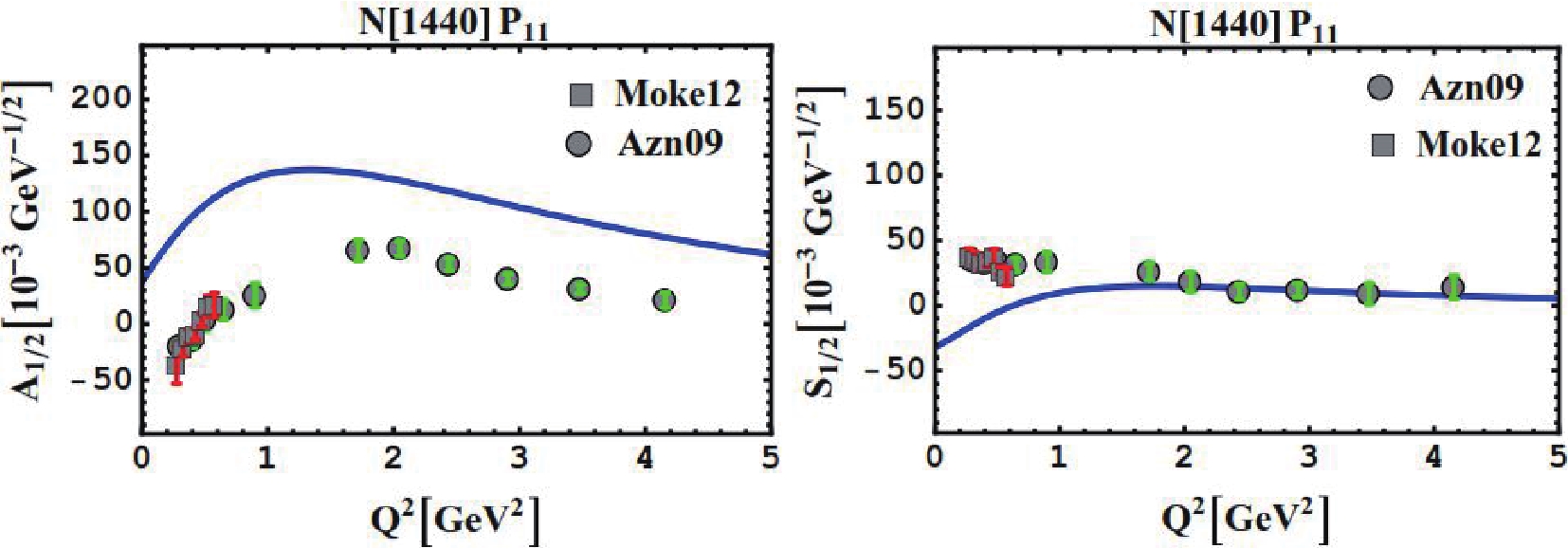 Figure2. (color online) Proton helicity ampitudes A1/2 and S1/2 for
Figure2. (color online) Proton helicity ampitudes A1/2 and S1/2 for  Figure3. (color online) The
Figure3. (color online) The 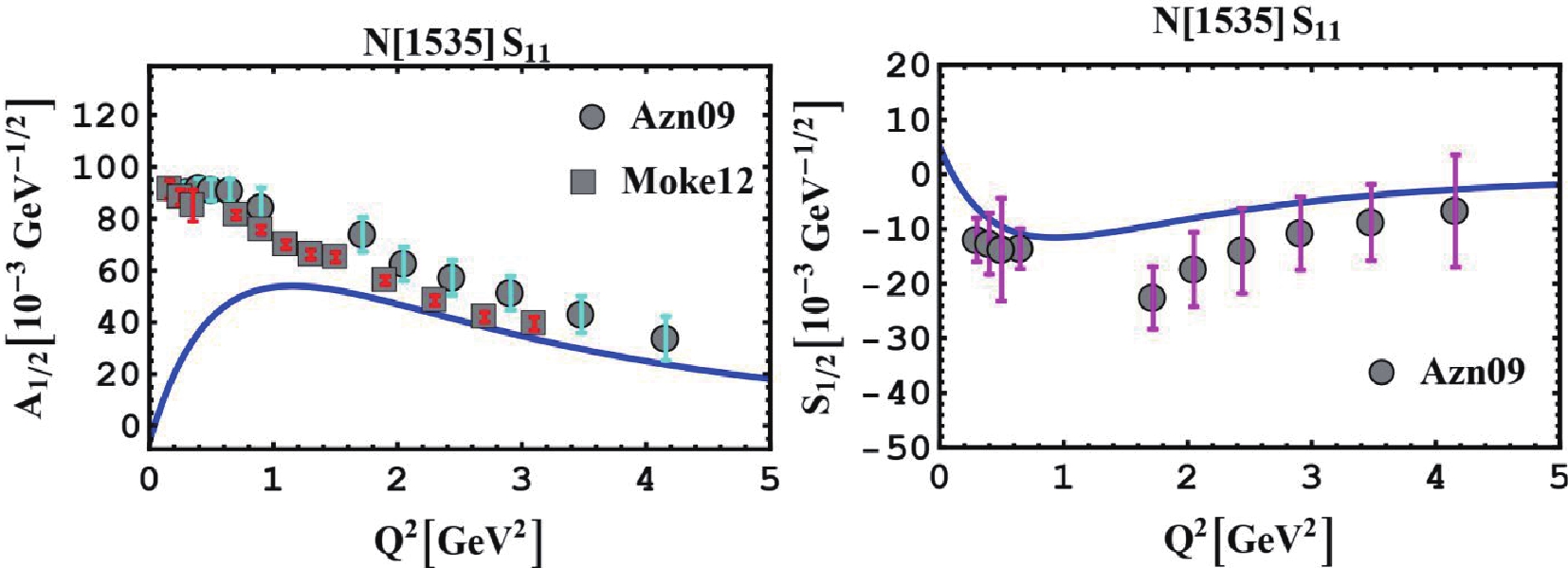 Figure4. (color online)
Figure4. (color online) 2
5.2.Excitation to Δ resonances
Figure 5 shows the transverse amplitudes A3/2 and A1/2 for Δ(1232)P33 states. At the photon point, the calculated values agree with the PDG data [32]. The low Q2 behavior is fairly well reproduced [43-45], while the medium-high Q2 behavior decreases too slowly with respect to the data [36]. Thus, the helicity amplitudes are generally underestimated by the model. In this study, the theoretical value of the longitudinal transition amplitude S1/2 is zero, while it has been proven in the Refs. [46-48] that the longitudinal helicity amplitude is entirely determined by the pionic meson cloud. It is worthwhile pointing out that the ratio Figure5. (color online) Q2-dependence of helicity ampitudes A3/2 and A1/2 for Δ(1232) P33-resonance of proton predicted by present model (full curves), in comparison with the Maid2007 analysis [36] of the data by Refs. [44, 45]. PDG points [32] are also shown.
Figure5. (color online) Q2-dependence of helicity ampitudes A3/2 and A1/2 for Δ(1232) P33-resonance of proton predicted by present model (full curves), in comparison with the Maid2007 analysis [36] of the data by Refs. [44, 45]. PDG points [32] are also shown. ${R_{\rm EM}} = - \frac{{{G_E}}}{{{G_M}}} = \frac{{{{{A}}_{1/2}} - {A}_{3/2}/\sqrt 3 }}{{{A_{1/2}} + \sqrt 3 {A}_{3/2}}},$  | (31) |
The Δ(1600)P33 resonance is considered the Roper-like excitation of Δ(1232). To date, there is no experimental data available on photon virtualities Q2 > 0 for the
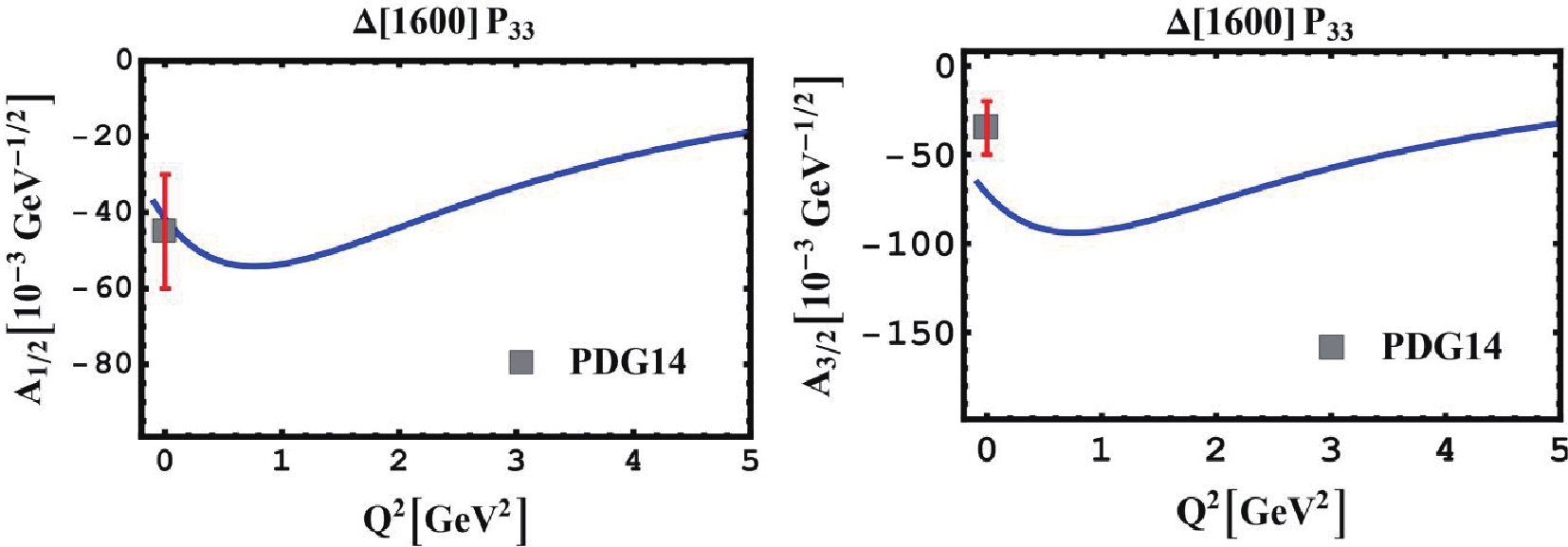 Figure6. (color online) Proton helicity ampitudes A1/2 and A3/2 for Δ(1600) P33 resonance. PDG points [32] are also shown.
Figure6. (color online) Proton helicity ampitudes A1/2 and A3/2 for Δ(1600) P33 resonance. PDG points [32] are also shown.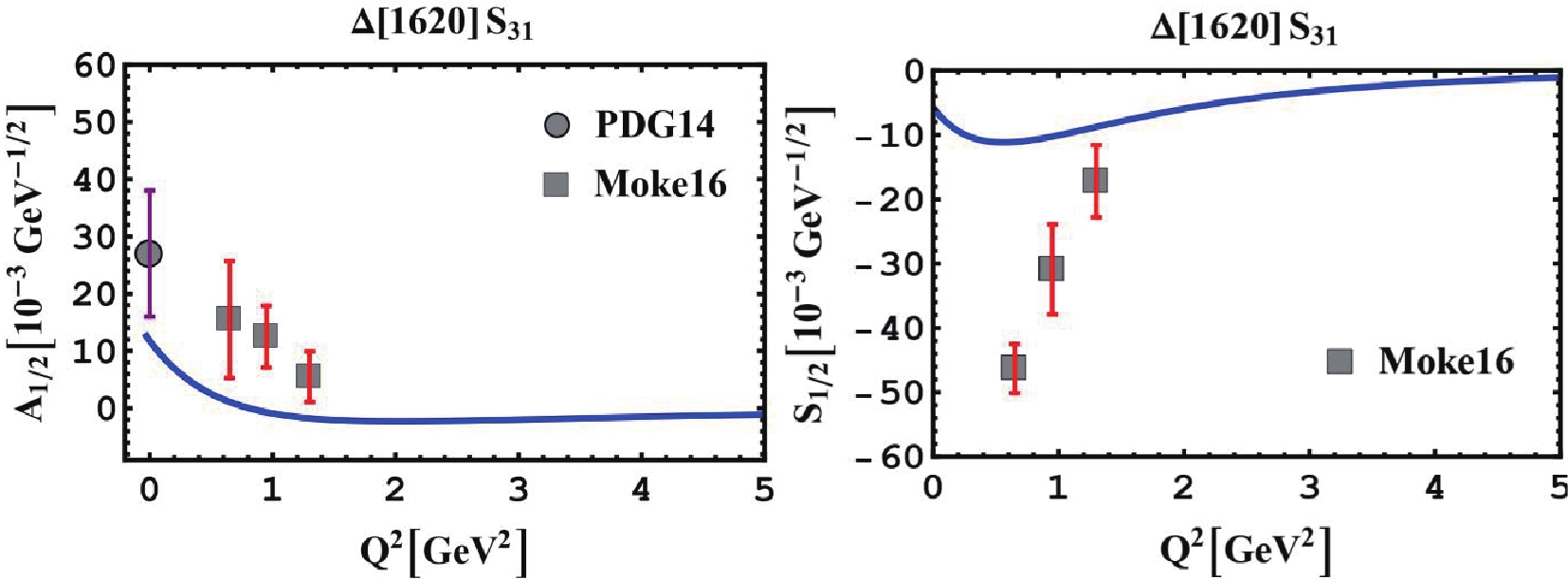 Figure7. (color online) Q2-dependence of A1/2 and S1/2 helicity ampitudes for Δ(1620) S31-resonance of the proton, compared to experiment data [39, 52]. PDG points [32] are also shown.
Figure7. (color online) Q2-dependence of A1/2 and S1/2 helicity ampitudes for Δ(1620) S31-resonance of the proton, compared to experiment data [39, 52]. PDG points [32] are also shown.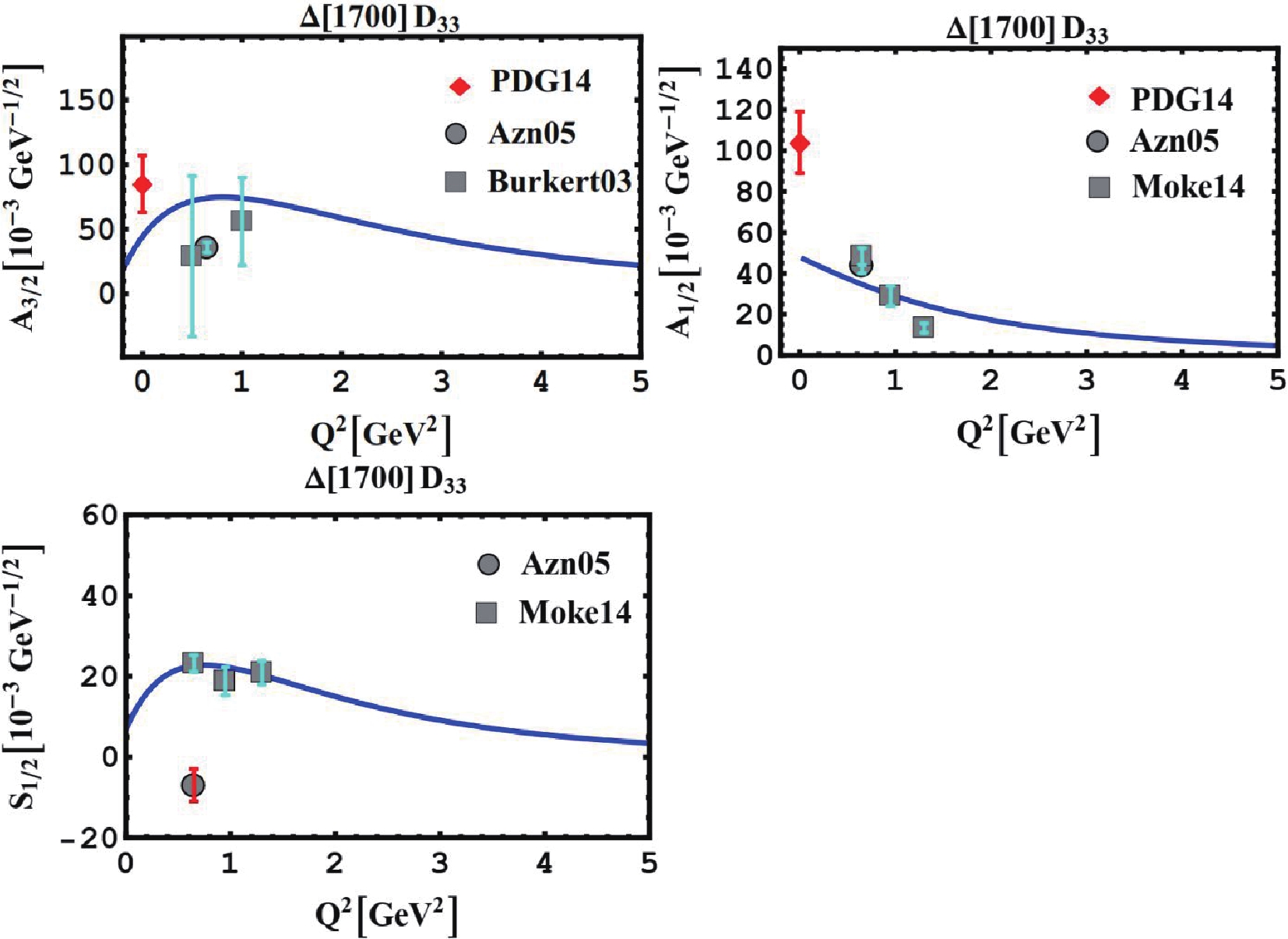 Figure8. (color online) Proton helicity ampitudes A3/2, A1/2, and S1/2 for excitation of Δ(1700) D33 compared to data in Refs. [39, 46]. PDG points [32] are also shown.
Figure8. (color online) Proton helicity ampitudes A3/2, A1/2, and S1/2 for excitation of Δ(1700) D33 compared to data in Refs. [39, 46]. PDG points [32] are also shown. $\tag{A1}{{\rm{\Psi }}_{3q}} = {\Psi _{3q}}\left( {{\bf{\rho }},{\bf{\lambda }}} \right){\rm{}}.{\chi _{\rm spin}}.{\rm{}}{\phi _{\rm isospin}}{\rm{}}.{\rm{}}{{\rm{\Theta }}_{\rm color}}.$  | (A1) |
$\tag{A2}\begin{split}{\vartheta _{\rm S}} =& \left| {\left( {\left( {\frac{1}{2},\frac{1}{2}} \right)1,\frac{1}{2}} \right)\frac{3}{2}} \right\rangle ,\;\;\;\;\;\;{\vartheta _{\rm MS}} = \left| {\left( {\left( {\frac{1}{2},\frac{1}{2}} \right)1,\frac{1}{2}} \right)\frac{1}{2}} \right\rangle {\rm{}},\\{\vartheta _{\rm MA}} =& \left| {\left( {\left( {\frac{1}{2},\frac{1}{2}} \right)0,\frac{1}{2}} \right)\frac{1}{2}} \right\rangle .\end{split}$  | (A2) |
$\tag{A3}\begin{split}{{\rm{\Omega }}_{\rm S}} = \frac{1}{{\sqrt 2 }}\left[ {{\chi _{\rm MA}}\;{\phi _{\rm MA}} + {\chi _{\rm MS}}\;{\phi _{\rm MS}}} \right]{\rm{}},\;\;{{\rm{\Omega }}_A} = \frac{1}{{\sqrt 2 }}\left[ {{\chi _{\rm MA}}\;{\phi _{\rm MS}} - {\chi _{\rm MS}}\;{\phi _{\rm MA}}} \right],\\{{\rm{\Omega }}_{\rm MS}} = \frac{1}{{\sqrt 2 }}\left[ {{\chi _{\rm MA}}\;{\phi _{\rm MA}} - {\chi _{\rm MS}}\;{\phi _{\rm MS}}} \right],\;\;{{\rm{\Omega }}_{\rm MA}} = \frac{1}{{\sqrt 2 }}\left[ {{\chi _{\rm MA}}\;{\phi _{\rm MS}} + {\chi _{\rm MS}}\;{\phi _{\rm MA}}} \right].\end{split}$  | (A3) |
| Resonance |   | S | T | SU(6) configurations |
| P11 |   |   |   |   |
  |   |   |   | |
  |   |   |   | |
  |   |   |   | |
  |   |   |   | |
| P33 |   |   |   |   |
  |   |   |   | |
  |   |   |   | |
  |   |   |   | |
  |   |   |   | |
| S11 |   |   |   |   |
  |   |   |   | |
  |   |   |   | |
  |   |   |   | |
| S31 |   |   |   |   |
  |   |   |   | |
| D13 |   |   |   |   |
  |   |   |   | |
  |   |   |   | |
  |   |   |   | |
| D33 |   |   |   |   |
  |   |   |   |
Table4.Three-quark states with positive and negative parity. Column 2 lists the angular momentum, parity, and S3-symmetry;
